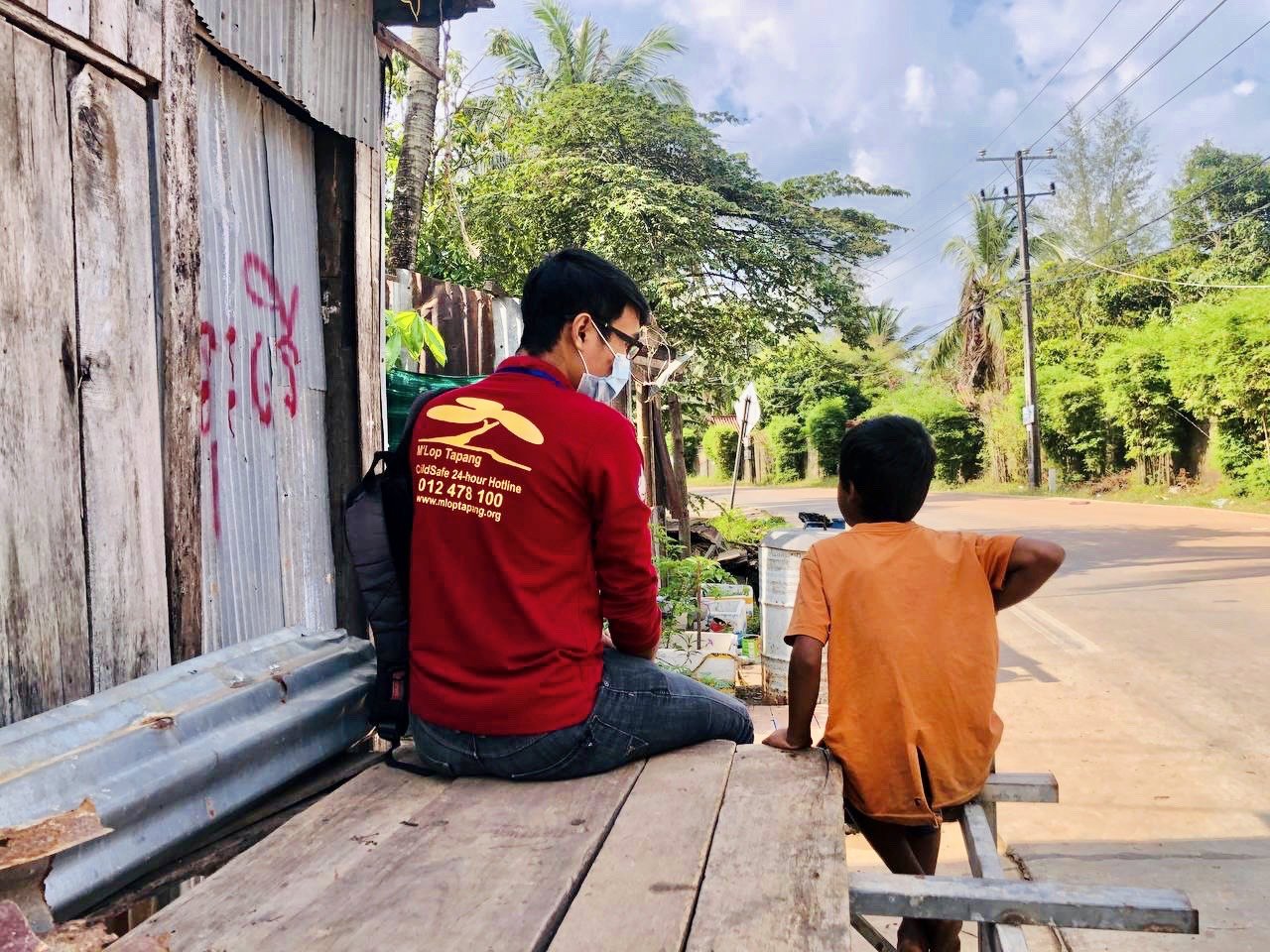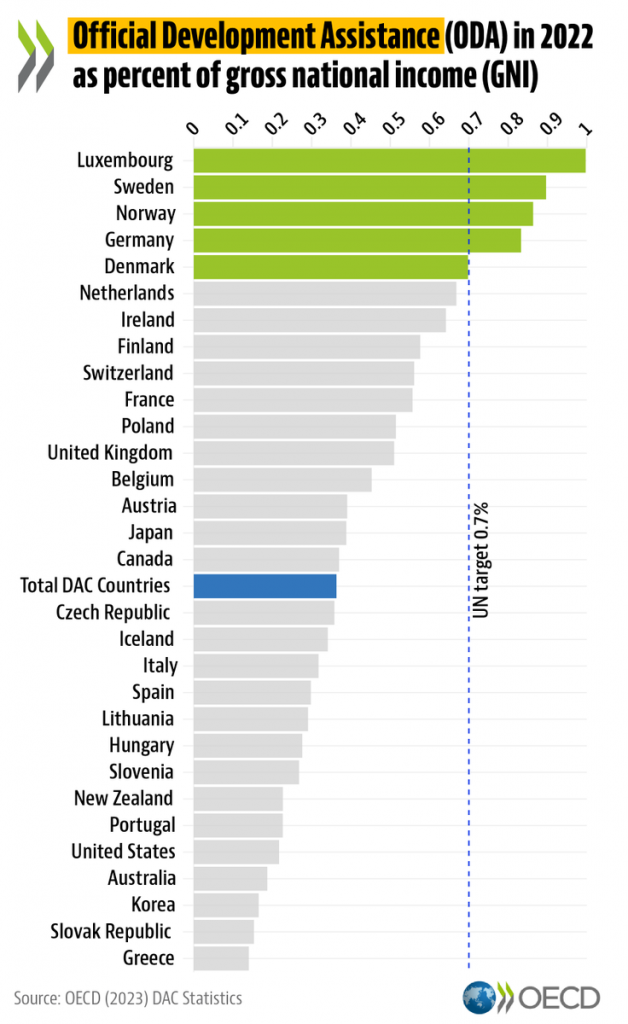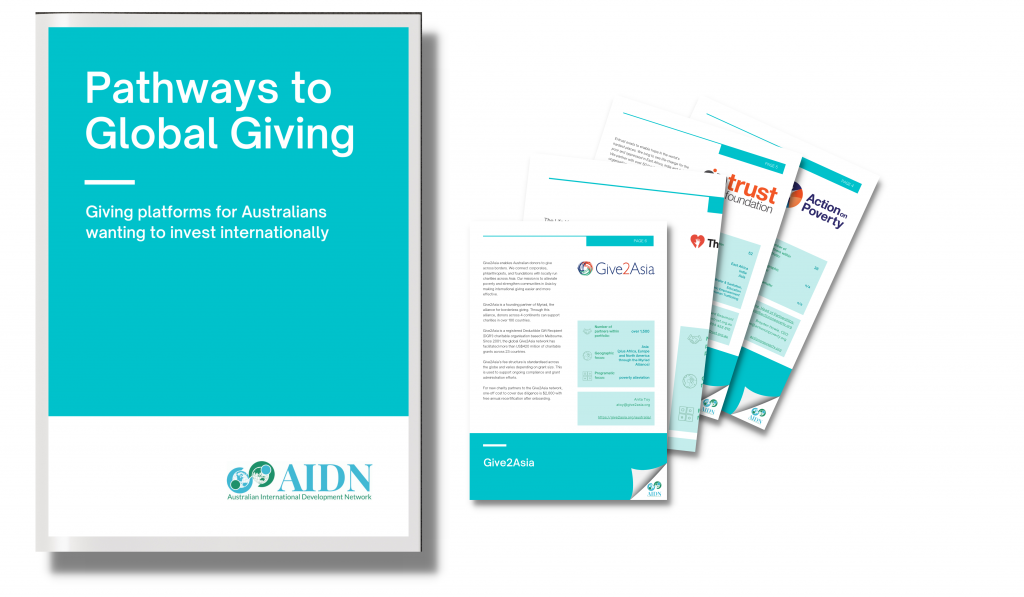In this special edition three-part blog series, the team at AIDN argue that the case for global giving has never been more compelling.
This series is based on AIDN’s three-part flagship series ‘The Compelling Case for Global Giving’ and was co-authored by Mark Cubit, Hannah McNicol and Emily Umbers.
In Part 1 of this special series, the Australian International Development Network (AIDN) team argued that there has never been a more compelling case for global giving. From responding to urgent on-the-ground humanitarian needs, to shifting geopolitics, to greater ‘bang for your buck’, all Australians should consider enriching and internationalising their giving portfolio. That is what we are all about at the AIDN.
However, despite these diverse and compelling reasons to give globally, currently, international philanthropy only accounts for ~10c in every dollar of giving by Australians. According to JBWere’s John McLeod, since the Australian Charities and NFPs Commission (ACNC) commenced collecting data on Australian donations in 2014, there has been an overall downturn trend. Whilst the value of tax-deductible donations has increased over the past decade, Australia is becoming less generous, with the actual number of people claiming tax deductible donations falling to its lowest level since the 1970s (Social Ventures Australia 2021, ATO data). Essentially, fewer people are giving but those who are giving are giving more. This poses a serious issue for international development which relies on 70-75% of its income from retail fundraising. Compounding this is Australia’s falling government commitment to Overseas Development Assistance (ODA). Whilst global ODA surged to an all-time high of USD 204 billion in 2022 – Australia ranked 28th (OECD 2023).
These damning statistics represent the fact that a range of stubborn, inflated misconceptions continue to create barriers that undermine Australia’s appetite for international giving. It’s time we break down these barriers.
A Matter of Trust
Issues of trust remain a significant obstacle to a sustained flow of giving from Australians to overseas causes. For a conventional market to work effectively, consumers need adequate information about the price, quality and characteristics of goods and services on offer, and confidence that they will get what they paid for. Donors similarly need adequate information to feel secure when they give (Australian Philanthropy Productivity Commission ToR 2023). This situation is only amplified in the context of international giving. AIDN repeatedly encounters the same critical questions including ‘How do I know if my money gets there? How do I know if my money will be spent prudently? Who can I trust?’. Issues such as embezzlement and corruption are also regularly flagged.
This lack of trust is naturally fuelled by the disconnection between Australians and overseas markets, or knowledge gaps surrounding the local political, economic, or social dynamics of the overseas organisation.
Anita Toy, Chief Representative at Give2Asia, explains that as charities abroad don’t necessarily meet the same reporting and disclosure requirements as Australian charities it can be harder for donors to trust or understand the efficacy of the charity. Amplifying this issue is the fact that many foundations or donors looking to give globally do not physically see or engage with work on-the-ground. The detrimental overemphasis in the media on negative cases of charity work also continues to diminish trust (Third Sector News, 2015). When was the last time you saw the media actually spotlight an overseas charity’s success?
However, there are many trustworthy organisations doing fantastic work internationally and it is important for donors to plug into networks like AIDN to find them. Tapping into giving networks is also pivotal for connecting with fellow like-minded funders or sharing vital information. For example, Jasmine Social Investments have an admirable track record in sharing their due diligence with others who want to make a real difference.
Will my money make an impact?
Donors may also be worried about the impact of their donation or if it is being effectively measured. However, again, there are numerous resources available to evaluate the effectiveness of charities, such as GiveWell or the Australian market focused ChangePath. These platforms independently assess charities using a range of data and further speak to the ongoing Monitoring and Evaluation (M&E) obligations that regulated charities must adhere to in order to show impact and sustainability. These resources should empower donors to feel confident to give more.
How about governance and regulation?
Continuing perceptions that international charities are not appropriately governed, or money imprudently used, also persist. However, potential donors should be aware of the regulatory and compliance work underpinning and strengthening Australian charities operating abroad. The Australian Charities and Not-for-Profit Commission (ACNC) maintains a searchable public register that provides a range of information including whether organisations are up to date with their reporting obligations, the names of the people managing a charity’s governance, and their current sources of funding and size. These resources should enhance public trust, confidence, and awareness in the sector by giving prospective donors an understanding of a charity’s accountability and purpose (Productivity Commission ToR 2023 p.21).
On top of this, over 130 Australian charities operating abroad are additionally members of the Australian Council for International Development (ACFID). All ACFID members are subject to the ACFID Code of Conduct which is recognised by the ACNC, is a prerequisite for Department of Foreign Affairs and Trade (DFAT) funding and ensures that charities demonstrate transparent fundraising, operations and finances. Members are also subject to a regulated public complaint system. As Mark Purcell, CEO of ACFID, explains in reality this double regulation means that Australian charities operating overseas are arguably subject to more governance than their domestic counterparts. With two regulatory bodies derisking donations or investments – donors should feel confident in their ability to give and make a significant contribution to important causes abroad (Case for Global Giving, 2022).
For organisations that are not registered as an Australian charity, there are also giving platforms such as Partners for Equity, Give2Asia, Global Development Group, Action on Poverty and more that carry out thorough due diligence. As Mark Cubit of Partners For Equity puts it, ‘We saw the empty land, we saw the classroom construction, we see the teachers in the classrooms full of children and we read the safeguarding and financial audit reports. We can be as confident of our impact as with a project in Geelong or Brisbane’. AIDN has collated the Pathways to Global Giving into an eBooklet which links donors to the various organisations who have portfolios of overseas partners and includes extensive due diligence protocols.
Can I benefit from tax deductibility when giving abroad?
Finally, the perception that global giving does not benefit from the same tax deductibility benefits as domestic giving continues to be a major barrier to global giving from Australians. Historically, international philanthropic giving in Australia was dominated by major players including World Vision and Save The Children. However, today we have a rich tapestry of smaller Australian run NGOs overseas, as well as many intermediaries that can give trusted access to NGOs run by non-Australians. This explosion of NGOs over the past decade was underpinned by The Hunger Project decision in 2014 that found that a fundraising organisation based in Australia could register as a public benevolent institution (PBI) and offer tax deductibility even though the implementation of their work was conducted by a separate entity offshore.
There are now a number of ways for Australian capital and income to meet needs ashore and ensure tax deductibility, from INGOs (that channel Australian funding to partner organisations and projects overseas such as Medicines Sans Frontières, World Vision and The Hunger Project), to single focus NGOs (Australian based PBIs that channel funding to a partner organisation such as The School of St Jude and Blue Dragon Children’s Foundation), giving platforms (Give2Asia, Partners for Equity or the Life You Can Save), social enterprises (Thank You and Who Gives A Crap), to impact investing (such as Good Return and LendForGood).
After debunking these myths, will we see you on the global giving journey?
Be sure to read part 3 of this series to find out How to start your impactful global giving journey


